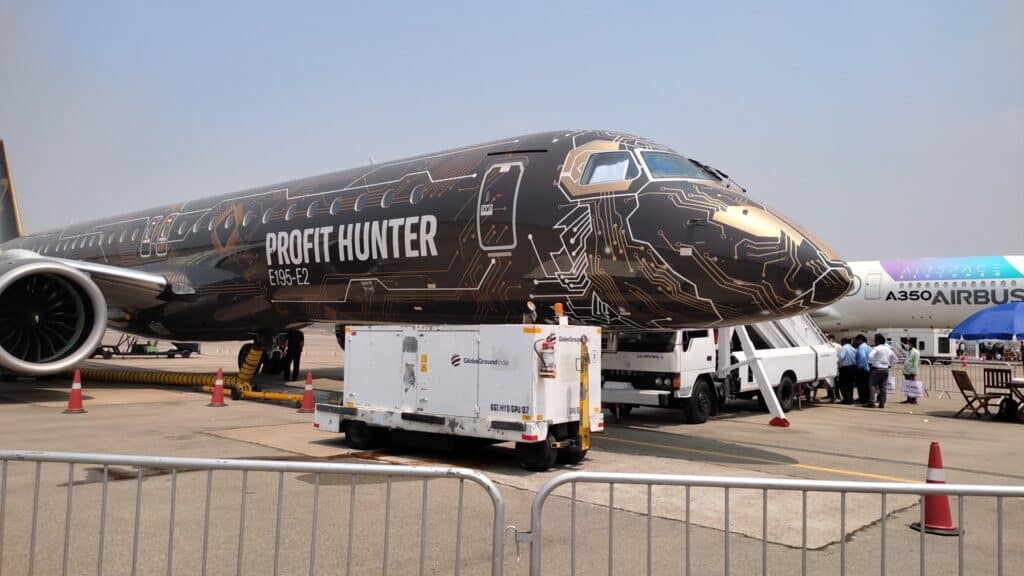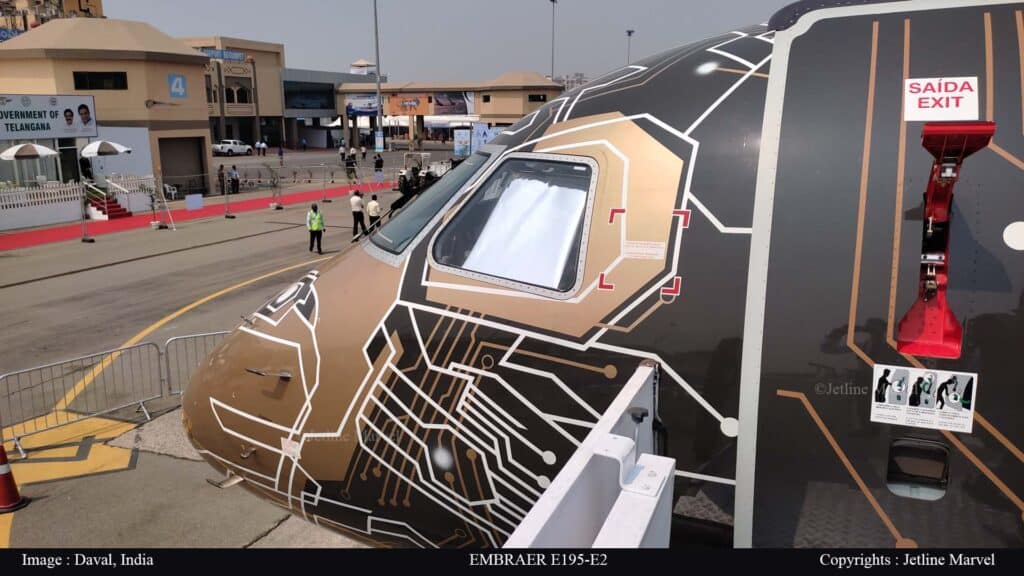Aerospace
How Embraer E195 will be the best fit for Air India.
How Embraer E195 will be the best fit for Air India.

Air India is restructuring its fleets in preparation for its upcoming big airline operations, which might position it as Asia’s largest airline in terms of fleet and traffic volume. “If the Tata Group cannot make Air India work, no one else in the country will be able to,” says Event Emirates CEO. Air India already has its own fleets that operate on a national and international scale.
Air India may be trailing in several areas, such as fleet selection. It is in high demand in both the domestic and foreign markets. It has preserved its tradition and brand because it was once a flag carrier. As time passes, the majority of its fleet is insufficient for the operator to provide more services, thus certain aircraft ranging from 130 to 220 seats are required, which should be ideal for regional connections.
According to Bloomberg, Air India is looking for narrow body aircraft akin to the Airbus A320 and Boeing 737 that can link to national and international destinations. On the other hand, it has the option of operating aircraft in zones or bases such as the north, south, east, and west, and if it does so, this aircraft will undoubtedly become a bigger player in that region, similar to how Air Asia and Indigo focused on perfect region selection and deployed aircraft based on demand and aircraft seat capacity.
[smartslider3 slider=”3″]
How would the Embraer E195 be most suitable for Air India’s regional routes?
If Air India executes so, the aircraft will undoubtedly require 100 to 140 seats, for which Embraer will be the most suited aircraft. This aircraft, in comparison to others, has a large capacity and has already been used in several nations to implement a similar type of marketing plan of connecting 1000 km to 4000 km range connectivity.
Note: Embraer does not recommend/requested us for aircraft promotion. This is an independent fleet fulfilment analysis.
[the_ad id=”13559″]
Embraer E jet family aircraft features.
This aircraft will be suited for Air India’s operations in terms of requirements. It has a track record of success and is also noted in the private and military jet industries. This aircraft has witnessed major advancements since its introduction to the aviation industry.
The Embraer E-Jet family is a series of four-abreast narrow-body short- to medium-range twin-engine jet airliners made by Brazilian aerospace firm Embraer. The E-Jet family is utilized by both mainline and regional airlines around the world, with regional airlines in the United States being particularly popular.
Embraer E-Jets are divided into two commercial families and a business jet variant. The basis model aircraft are the smaller E170 and E175. The E190 and E195 are stretched versions with larger wing, horizontal stabilizer, and landing gear sections.
[the_ad id=”13559″]
All E-Jets have four-abreast seating (2+2) and a “double-bubble” configuration created by Embraer for their commercial passenger jets that allows stand-up headroom. Embraer has delivered high-quality aircraft and services while staying on schedule. When discussing the entire range of aircraft types, Republic Airways (212), SkyWest Airlines (151), Mesa Airlines (80), Envoy Air (62) and JetBlue were the five largest operators of the E-Jet family as of March 2021. (60)
This aircraft has 130 seats in two classes, with dual class seats accommodating up to 100 passengers. The aircraft has a maximum take-off weight of 52,290kg and a basic operating weight of up to 28.667kg. It is powered by a GE CF34 engine that generates 89 kilo newton’s of thrust. This aircraft has a top speed of 871 km/hr and a range of 4,260 km, making it ideal for connecting Indian regions.
Embraer E-Jets E2 family features:
Embraer’s E-Jet E2 family of medium-range jet airliners is the successor to the first E-Jet. The program debuted during the 2013 Paris Air Show. The first variant, the E190-E2, flew for the first time on May 23, 2016, and was certified on February 28, 2018, before entering service with Widere on April 24, 2018.
When it comes to single configuration seats, the Embraer E 195 E has a capacity of 124 to 132. It has a maximum take-off weight of roughly 61,500 kg and a cargo capacity of 16,150 kg. It has a top speed of 833 km/h. The range is 4,917 km, and the engine produces 105 kN force.
There were 54 E2-Jet aircraft in commercial service as of March 2021, with 9 operators. Helvetic Airways (12), KLM Cityhopper (11), Azul Brazilian Airlines (9), Air Astana (5), and Binter Canarias (5) were the top five operators (5)
[the_ad id=”13562″]
The three twinjet variants share a four-abreast narrow-body fuselage with varying lengths and three different new wings, two Pratt & Whitney PW1000G turbofans, fly-by-wire controls with new avionics, and a revised cabin.
It is a competitor to the Airbus A220-300. Because of its low unit costs, the E195-E2 might open up a new market and generate high demand, propelling it into mainline territory. Embraer claims E195 trip costs are 22% less than a 154-seat A320neo and 24% less than a 160-seat 737-8 – yet airlines install extra seats, causing seat costs to differ more than the 6% and 8% claimed by Embraer.
The improved flying stability and accompanying greater lift (lower tail downward force) and weight savings and drag reductions associated with the 26 percent reduction in horizontal tail (tail plane) size result in fuel savings with the now closed loop fly-by-wire control. The adoption of fly-by-wire ailerons, which are also engaged when braking, reduced the weight of the wing structure by 200 kg (440 lb).
According to Embraer, the number of advancements made in earlier generations of aircraft has increased efficiency, resulting in a 25% reduction in fuel consumption per seat when compared to A220-300 aircraft.
Most airlines in India utilise ATR aircraft for small-area connectivity since their engines are noisy, but Embraer uses Pratt & Whitney engines, which are quieter than ATR engines. Star Air currently operates the E145 ERJ in South India.
[the_ad id=”13559″]
Air India Regional connectivity.
If Air India is considering regional connections, the Embraer will be an excellent choice. In terms of competition, this aircraft is up against the Airbus A220. If Air India operates short regional flights with fewer passengers, this aircraft might be ideal. Even some surveys have revealed that Indian-based airlines fly aircraft with passenger capacities ranging from 120 to 150 people. In such instances, this can meet the needs of any airline.
Share your thoughts on this Embraer aircraft for Air India in the comments area. Read our other article about Embraer cabin features : here

Aerospace
When Ratan Tata was denied entry to the airfield at the Aero India show, he waited

During our visit to Aero India 2019, we had the unexpected opportunity to see Ratan Tata at the event, which was a thrilling moment for us. However, there was a surprising hiccup when the security staff didn’t allow him to enter due to a lack of a security pass.
Despite this, he remained calm and patiently waited for about 20 minutes until a member of the Tata team brought him the required pass, after which he calmly proceeded inside. It was a humbling sight, showcasing his composed demeanor even in such situations.
Ratan Tata ji is not only a renowned industrialist but also a trained pilot, holding a pilot’s license. In 2007, he became the first Indian civilian to fly the F-16 Falcon during the Aero India show in Bangalore—a proud moment for the nation.
His passion for aviation extended beyond flying, as he played a key role in shaping India’s aerospace industry. Under his leadership, Tata ventured into manufacturing and maintaining aerospace components while upholding its legacy of quality. Notably, Tata’s collaboration with Airbus to develop and manufacture the C295 aircraft is a testament to its growing influence in the sector.
-

 Aviation2 months ago
Aviation2 months agoMicrosoft Flight Simulator Raises $3 Million to Bring Back the An-225 Mriya
-

 Airlines2 months ago
Airlines2 months agoQantas Engineers Stage Walkout Over Cost of Living Concerns
-

 Airlines2 months ago
Airlines2 months agoQatar Citizens Can Travel to the United States Without a Visa
-

 Aviation2 months ago
Aviation2 months agoQatar Airways bans these new Electronic Devices on plane
-

 Airlines2 months ago
Airlines2 months agoJapan Airlines Rolls Out Free Domestic Flights to International Passengers
-

 Defence2 months ago
Defence2 months agoWhich Country Has the Largest Fleet of Fighter Aircraft?
-

 Airport2 months ago
Airport2 months agoWestern Sydney Airport Welcomes Its First Plane After 6 Years of construction
-

 Aviation2 months ago
Aviation2 months agoDid you know ? Once Boeing 747 carried 1088 passenger in 1991











